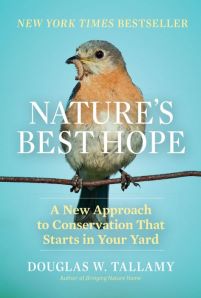How to save the planet? Start in your own back yard.

New construction has completely changed the character of my neighborhood. You’ve probably seen it, too — developers buying up old houses in established neighborhoods and demolishing them, plowing up gardens, and putting outsized McMansions with three-car garages on the lots.
Virginia’s environmental policies are among the most progressive in the nation. But in the Falls Church neighborhood where I live, they’ve been felling broad canopy trees at a dizzying rate. They replace them with saplings, uproot shrubbery, and erect privacy fences.
Because of the sheer size of the new houses and the loss of trees, our groundwater table has shifted. When it rains, water now rushes through our properties where it never did before. While the new places sell for more than a $1 million, homeowners are saddled with installing expensive drainage systems to cope with flooded lawns and basements.
But there’s another movement afoot: the growing popularity of environmentally friendly gardening options. Some of us are beginning to realize that it’s not enough to leave conservation in the hands of a few ecologists and park-service professionals. It’s time to participate actively, starting with our own back yards.
I live in a small house with an enormous garden. During the pandemic, we experimented with growing a meadow but soon came to realize we didn’t know what we were doing. So, last month, I got in touch with a native-plant landscaper who recommended a couple books by Douglas W. Tallamy, a professor in the Department of Entomology and Wildlife Ecology at the University of Delaware.
Bringing Nature Home deals with the importance of insect life and native plants. Tallamy’s more recent book, Nature’s Best Hope, is a lively exploration of the ways we can all partake in sustaining the wildlife and biodiversity of our gardens.
First, he says, we’ve got to rethink our devotion to the weedless green lawn, which is “the least productive of our plantings.” For all the upkeep they require, lawns do nothing to sustain native animals and birds. They go back to when people kept flocks of sheep on their property. If you were rich enough to have ornamental acreage rather than farmland, you planted a lawn as a status symbol.
Changing this mindset will take time. Some people who replace their lawns with native plants are taken to task by neighbors for lowering property values. But if we care about the environment, we can surely rethink what attractive yards should look like. As a step in that direction, Tallamy suggests we make native plantings look more deliberate by edging them.
“We reached our low point in environmental stewardship,” he writes in Nature’s Best Hope, “not because humans are evil beings that just like to kill things, but because we never abandoned the adversarial relationship with the natural world that enabled hunter-gatherer societies to survive.” That adversarial relationship blossomed some 10,000 years ago; since then, the human population has grown immeasurably.
Colorful, ornamental plantings of “alien species,” as he calls them, are understandably popular, but they don’t support native animal and bird life. I wondered what he meant by “alien.” I think of my garden as natural, even a little wild, but it turns out I’ve planted my fair share of aliens. According to Tallamy, it all comes down to function:
“[A plant can be considered native] when it has achieved the same ecological productivity that it had in its evolutionary homeland, when it has accumulated the same number of specialized relationships that had been nurtured by the native plant it displaced.”
And here’s another tip: Hold off on that expensive mulch delivery. It’s bad for the roots of your trees. The sustainable and economical approach is to recycle leaf mold and layer your plantings.
We’ve planted numerous trees over the years — cherry and apple, magnolia and crape myrtle. Oak trees are more expensive but would’ve been a much better choice. “Ecologically,” Tallamy writes, “oaks are superior plants, and it would be easy to make a convincing case that they deliver more ecosystem services than any other tree genus.” Come to think of it, some of the saplings the developers have planted are oaks. That should pay off in a few decades.
The habit of pest spraying is also highly misguided, as it kills the important and helpful insects on which other species rely. Thankfully, Tallamy does share an alternative method for controlling mosquitos. He also writes about encouraging bees and butterflies. Planting “weeds” such as goldenrod and asters is a great start; planting milkweed attracts monarch butterflies.
It’s depressing to think about the vast problem of climate change, especially if we as individuals can do so little to make a difference. But reading these books, I felt excited and more hopeful. Tallamy stresses that we can all participate in protecting and restoring the environment, no matter how small our plot may be. Even a balcony filled with the right kinds of potted plants can help.
Maybe I’m not quite ready to get rid of my nonnative crape myrtle and the willow I just planted. Nor did I like learning that some of my groundcover is invasive. But doing this project in phases is the easiest and most economical way forward. “I am willing to bet,” Tallamy writes, “that by helping to build Homegrown National Park, you will build a connection to place more powerfully and quicker than you ever have in the past.”
And who doesn’t want to do that?
Amanda Holmes Duffy, author of the novel I Know Where I Am When I’m Falling, is a book-club facilitator for Fairfax County Public Library and hosts the weekly podcast Read Me a Poem for the American Scholar.

